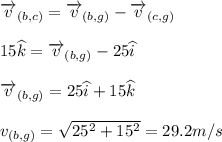
Physics, 25.06.2021 04:00 makayladurham19
you are traveling in a convertible with the top down. the car is moving at a constant velocty of 25 m/s due east along falt ground. you throw a tennis ball straight upward at a speed of 15 m/swhen the ball just leaves your hand, what is the speed of the ball as measured by an observer on the side of the road

Answers: 2


Other questions on the subject: Physics

Physics, 22.06.2019 09:40, goofy44
Aturntable a is built into a stage for use in a theatrical production. it is observed during a rehearsal that a trunk b starts to slide on the turntable 10 s after the turntable begins to rotate. knowing that the trunk undergoes a constant tangential acceleration of 0.31 m/s2, determine the coefficient of static friction between the trunk and the turntable.
Answers: 3

Physics, 22.06.2019 15:40, winterblanco
Question 1 what is amperage? is the rate of doing work. is the rate of flow of protons in electric current. represents the amount of pressure behind electron flow. is the rate of flow of electrons in electric current. 2 points question 2 what is voltage? is the rate of doing power. represents the amount of pressure behind electron flow. is the rate of doing work. is the rate of flow of electrons in electric current. 2 points question 3 what is power? is the rate of flow of protons in electric current. is the rate of flow of electrons in electric current. is the rate of doing work. represents the amount of pressure behind electron flow. 2 points question 4 if we multiply volts times amps we get what? power circuit work current 2 points question 5 what are two ways alternating currents are similiar? in both ac and dc electrons flow in the same pattern. in both ac and dc, the flow of electrons changes directions back and forth. both ac and dc are only possible in certain materials with atoms that will allow electron flow. both ac and dc involve the flow of electrons. 4 points question 6 how does the flow of electrons flow in an alternating current? the flow of electrons is always slower in an alternating current than within a direct current. the flow of electrons is not constant and forward; it changes direction back and forth. electrons flow from from a higher affinity to that of a lower affinity. electron flow is constant and only in a forward direction. 2 points question 7 what is the flow like in a direct current? the flow of electrons is not constant and forward; it changes direction back and forth. the flow of electrons is constant and only in a forward direction. the flow of electrons go from a higher affinity to a lower affinity. the flow of electrons are always faster in a direct current. 2 points question 8 how is an electric current able to flow? electrons flow from the higher affinity to lower affinity and electrical current is generated. protons flow from the higher affinity to lower affinity and electrical current is generated. the movement of protons from one atom to another leads to an electric charge. the movement of electrons from one atom to another atom in a line results in a flow of electric current. 2 points question 9 how do electrons move from the two different types of metal in a battery? protons flow from the metal with the lower affinity to the metal with higher affinity and electrical current is generated. electrons flow from the metal with the lower affinity to the metal with higher affinity and electrical current is generated. electrons flow from the metal with the higher affinity to the metal with lower affinity and electrical current is generated. protons flow from the metal with the higher affinity to the metal with lower affinity and electrical current is generated.
Answers: 2

Physics, 22.06.2019 20:50, dorkygirl
An ideal otto cycle has a compression ratio of 8. at the beginning of the compression process, air is at 95 kpa and 27°c, and 750 kj/kg of heat is transferred to air during the constant-volume heat-addition process. assuming constant specific heats at room temperature, determine (a) the pressure and temperature at the end of the heat-addition process, (b) the net work output, (c) the thermal efficiency, and (d) the mean effective pressure for the cycle. (4390 kpa, 1730 k; 423 kj/kg; 56.4%; 534 kpa)
Answers: 1

Physics, 23.06.2019 02:00, cj9508
Anoche fuimos al restaurante el gusto. jaime le (1) (pedir) al camarero una mesa en la sección de no fumar. yo (2) (pedir) chuleta de cerdo con champiñones, papas y ensalada y jaime (3) (pedir) mariscos, arroz y ensalada. el restaurante estaba lleno (full) por eso no nos (4) (servir) muy rápido (very fast), pero la comida estaba deliciosa. no me lo vas a creer (you won't believe it) pero ¡jaime (5) (repetir) arroz y mariscos! ¡dos porciones (orders)! ¿ya entiendes por qué él no (6) (dormir) bien anoche?
Answers: 2
You know the right answer?
you are traveling in a convertible with the top down. the car is moving at a constant velocty of 25...
Questions in other subjects:














